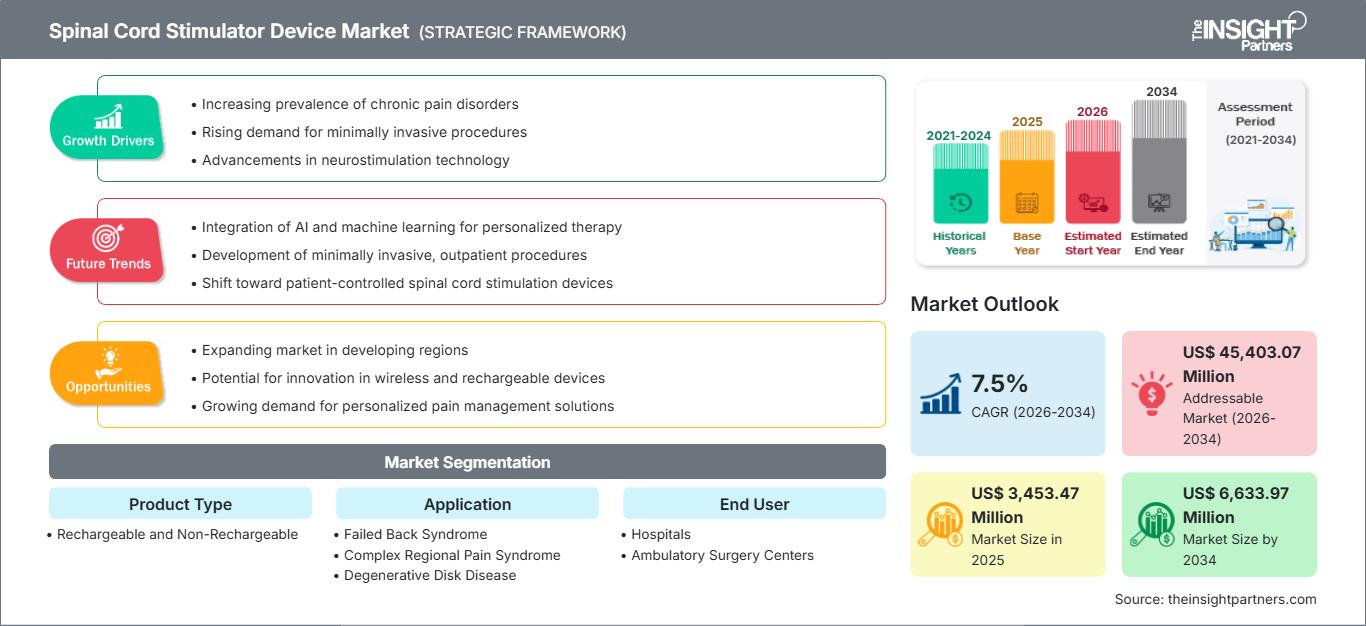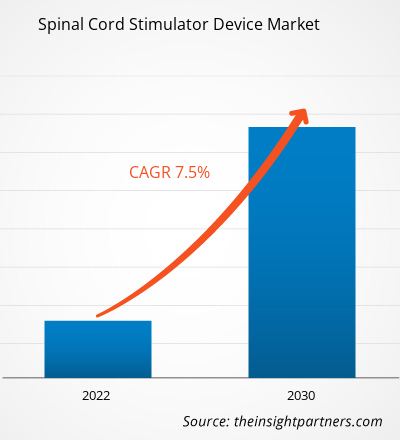Der Markt für Rückenmarkstimulationsgeräte, der 2025 einen Wert von 3.453,47 Millionen US-Dollar erreichte, wird bis 2034 voraussichtlich auf 6.633,97 Millionen US-Dollar anwachsen, was einem durchschnittlichen jährlichen Wachstum von 7,5 % im Zeitraum 2026–2034 entspricht. Die Marktbedingungen entwickeln sich stetig weiter und eröffnen den Akteuren neue Chancen. Insgesamt zeichnet sich der Markt durch stabile Fortschritte und langfristiges Wachstumspotenzial aus.
Wachstumstreiber und Herausforderungen:
Laut der National Library of Medicine (NLM) erleiden weltweit jährlich etwa 250.000 bis 500.000 Patienten eine Rückenmarksverletzung. Einem Bericht der Association for Spinal Injury Research, Rehabilitation and Reintegration (Aspire, UK) zufolge werden in Großbritannien jährlich etwa 2.500 Menschen mit einer Rückenmarksverletzung diagnostiziert. Derzeit leben in Großbritannien rund 50.000 Menschen mit dieser Verletzung. Das National Spinal Cord Injury Statistical Center (NSCISC) schätzt, dass in den USA etwa 320.000 Menschen mit einer traumatischen Rückenmarksverletzung leben. Laut einem Bericht des National Institute of Health (NIH) wird die hohe Anzahl an Fällen darauf zurückgeführt, dass Motocross und Motorradrennen weltweit zu den beliebtesten Sportarten zählen.
Darüber hinaus treten diese Verletzungen häufig bei älteren Menschen auf. Laut den im Rahmen der Weltbank-Entwicklungsindikatoren für 2022 veröffentlichten Daten sind in Deutschland 22,41 % der Bevölkerung über 65 Jahre alt. Ein von MDPI veröffentlichter Artikel gibt an, dass die Prävalenzrate traumatischer Rückenmarksverletzungen bei etwa 500 Fällen pro Million Einwohner liegt und die Inzidenzrate weltweit sogar 13 Fälle pro Million Einwohner erreicht.
Rückenmarksverletzungen haben lebensverändernde Auswirkungen auf die Betroffenen und ihre Familien. Die steigende Zahl von Rückenmarksverletzungen und die damit verbundene stationäre Behandlung führen dazu, dass jährlich mindestens ein Patient erneut stationär aufgenommen werden muss. Dies liegt daran, dass Rückenmarksverletzungen nicht sofort behandelt werden. Zu den Ursachen für erneute Krankenhausaufenthalte zählen Atemwegs- und Harnwegsinfektionen sowie Frakturen, die bei Motorradunfällen auftreten. Angesichts der steigenden Zahl von Rückenmarksverletzungen und der gut ausgebauten Infrastruktur in Behandlungszentren mit Rehabilitationsprogrammen wächst die Nachfrage nach Rückenmarkstimulationsgeräten in spezialisierten Einrichtungen und Rehabilitationszentren rasant und treibt so das Wachstum des Marktes für diese Geräte voran.
Passen Sie diesen Bericht Ihren Anforderungen an.
Sie erhalten eine kostenlose Anpassung aller Berichte – einschließlich Teilen dieses Berichts, Länderanalysen und Excel-Datenpaketen – sowie attraktive Angebote und Rabatte für Start-ups und Universitäten.
Markt für Rückenmarkstimulationsgeräte: Strategische Einblicke

-
Ermitteln Sie die wichtigsten Markttrends dieses Berichts.Diese KOSTENLOSE Probe beinhaltet eine Datenanalyse, die von Markttrends bis hin zu Schätzungen und Prognosen reicht.
Berichtssegmentierung und -umfang:
Der Markt für Rückenmarkstimulationsgeräte ist nach Produkttyp, Anwendung, Endnutzer und Region unterteilt. Nach Produkttyp wird zwischen wiederaufladbaren und nicht wiederaufladbaren Geräten unterschieden. Die Anwendungsgebiete umfassen das Postnukleotomie-Syndrom, das komplexe regionale Schmerzsyndrom, die degenerative Bandscheibenerkrankung und weitere Erkrankungen. Zu den Endnutzern zählen Krankenhäuser, ambulante Operationszentren und weitere Einrichtungen. Geografisch ist der Markt in Nordamerika (USA, Kanada und Mexiko), Europa (Großbritannien, Deutschland, Frankreich, Italien, Spanien, Russland und übriges Europa), Asien-Pazifik (China, Japan, Indien, Südkorea, Australien, Südostasien und übriges Asien-Pazifik), Naher Osten und Afrika (VAE, Saudi-Arabien, Südafrika und übriger Naher Osten und Afrika) sowie Süd- und Mittelamerika (Brasilien, Argentinien und übriges Süd- und Mittelamerika) unterteilt.
Segmentanalyse:
Der Markt für Rückenmarkstimulatoren ist nach Anwendungsgebiet in die Segmente Postnukleotomie-Syndrom, komplexes regionales Schmerzsyndrom (CRPS), degenerative Bandscheibenerkrankung und Sonstige unterteilt. Das CRPS-Segment hielt 2022 den größten Marktanteil und wird voraussichtlich im Zeitraum 2022–2030 die höchste durchschnittliche jährliche Wachstumsrate (CAGR) verzeichnen. CRPS ist durch anhaltende Schmerzen und Entzündungen gekennzeichnet, die infolge von Verletzungen oder anderen medizinischen Ereignissen wie Operationen, Traumata, Schlaganfällen und Herzinfarkten auftreten. CRPS kann überall im Körper auftreten, betrifft aber meist Arme, Beine, Hände oder Füße. Es kann in jedem Alter auftreten, wobei die Entzündung nach dem 40. Lebensjahr ihren Höhepunkt erreicht. In den meisten Fällen wird CRPS durch geschädigte oder fehlerhaft funktionierende C-Fasern im peripheren Nervensystem verursacht, die Schmerzsignale an das Gehirn weiterleiten. CRPS bleibt oft unentdeckt, da sich winzige Blutgerinnsel bilden, die die Blutzufuhr zu den Nerven blockieren und diese schädigen können.
Markt für Rückenmarkstimulationsgeräte nach Anwendungsbereich – 2022 und 2030
Regionalanalyse:
Der Markt für Rückenmarkstimulatoren ist geografisch in Nordamerika, Europa, Asien-Pazifik, den Nahen Osten und Afrika sowie Süd- und Mittelamerika unterteilt. Nordamerika trägt am meisten zum Wachstum des globalen Marktes für Rückenmarkstimulatoren bei. Für Asien-Pazifik wird von 2022 bis 2030 die höchste durchschnittliche jährliche Wachstumsrate (CAGR) erwartet. Das stetig steigende Auftreten von Rückenmarksverletzungen trägt maßgeblich zu diesem Marktwachstum bei. Rückenmarksverletzungen stellen derzeit eine erhebliche gesundheitliche Belastung in Nordamerika dar. Laut Spinal Cord Inc. erleiden jährlich rund 18.000 Menschen in den USA solche Verletzungen.
Rückenmarkstimulationsgerät
Markteinblicke für Rückenmarkstimulationsgeräte
Die regionalen Trends und Einflussfaktoren auf den Markt für Rückenmarkstimulationsgeräte im gesamten Prognosezeitraum wurden von den Analysten von The Insight Partners eingehend erläutert. Dieser Abschnitt behandelt außerdem die Marktsegmente und die geografische Verteilung des Marktes für Rückenmarkstimulationsgeräte in Nordamerika, Europa, Asien-Pazifik, dem Nahen Osten und Afrika sowie Süd- und Mittelamerika.
Marktbericht über Rückenmarkstimulationsgeräte – Umfang
| Berichtattribute | Details |
|---|---|
| Marktgröße im Jahr 2025 | 3.453,47 Millionen US-Dollar |
| Marktgröße bis 2034 | 6.633,97 Millionen US-Dollar |
| Globale durchschnittliche jährliche Wachstumsrate (2026 - 2034) | 7,5 % |
| Historische Daten | 2021-2024 |
| Prognosezeitraum | 2026–2034 |
| Abgedeckte Segmente |
Nach Produkttyp
|
| Abgedeckte Regionen und Länder |
Nordamerika
|
| Marktführer und wichtige Unternehmensprofile |
|
Marktdichte der Akteure im Markt für Rückenmarkstimulationsgeräte: Auswirkungen auf die Geschäftsdynamik verstehen
Der Markt für Rückenmarkstimulationsgeräte wächst rasant, angetrieben durch die steigende Nachfrage der Endverbraucher. Gründe hierfür sind unter anderem sich wandelnde Verbraucherpräferenzen, technologische Fortschritte und ein wachsendes Bewusstsein für die Vorteile des Produkts. Mit steigender Nachfrage erweitern Unternehmen ihr Angebot, entwickeln innovative Lösungen, um den Bedürfnissen der Verbraucher gerecht zu werden, und nutzen neue Trends, was das Marktwachstum zusätzlich beflügelt.

- Überblick über die wichtigsten Akteure auf dem Markt für Rückenmarkstimulationsgeräte
Branchenentwicklungen und Zukunftschancen:
Die wichtigsten Initiativen der Hauptakteure auf dem Markt für Rückenmarkstimulationsgeräte sind nachfolgend aufgeführt:
- Im August 2022 erhielt Abbott Laboratories von der US-amerikanischen Arzneimittelbehörde FDA die Zulassung für sein Proclaim PlusSCS-System zur Behandlung chronischer Schmerzen. Die BurstDR-Stimulationstechnologie ermöglicht eine überlegene Schmerzlinderung. Das Gerät bietet die FlexBurst360-Therapie, die Schmerzen im gesamten Rumpf- und Extremitätenbereich abdeckt und individuell an die sich verändernden Therapiebedürfnisse des Patienten angepasst werden kann.
- Im Dezember 2022 wird das Eterna-Rückenmarkstimulationssystem (SCS) von Abbott Laboratories zur Behandlung chronischer Schmerzen verfügbar sein. Abbotts patentierte Niedrigdosis-BurstDR-Stimulationstechnologie, eine Niedrigdosis-SCS-Wellenformtechnologie mit umfassender klinischer Evidenz, wurde von der FDA zugelassen. Darüber hinaus konnte gezeigt werden, dass diese Technik eine um 23 % stärkere Schmerzlinderung bewirkt als herkömmliche, auf Wellenformtechnologie basierende Verfahren.
Wettbewerbsumfeld und Schlüsselunternehmen:
Zu den führenden Anbietern auf dem Markt für Rückenmarkstimulatoren zählen Boston Scientific Corp., Nevro Corp., Abbott Laboratories, Cirtec Medical Corp., Medtronic Plc, Biotronik SE & Co KG, Curonix LLC, Nalu Medical, Inc. und Synapse Biomedical Inc. Diese Unternehmen konzentrieren sich auf die Einführung neuer Produkte und die geografische Expansion, um die weltweite Kundennachfrage zu decken und ihr Produktportfolio im Spezialbereich zu erweitern. Ihre globale Präsenz ermöglicht es ihnen, einen großen Kundenstamm zu bedienen und so die Marktexpansion zu fördern.
- Historische Analyse (2 Jahre), Basisjahr, Prognose (7 Jahre) mit CAGR
- PEST- und SWOT-Analyse
- Marktgröße Wert/Volumen – Global, Regional, Land
- Branchen- und Wettbewerbslandschaft
- Excel-Datensatz
Aktuelle Berichte
Erfahrungsberichte
Grund zum Kauf
- Fundierte Entscheidungsfindung
- Marktdynamik verstehen
- Wettbewerbsanalyse
- Kundeneinblicke
- Marktprognosen
- Risikominimierung
- Strategische Planung
- Investitionsbegründung
- Identifizierung neuer Märkte
- Verbesserung von Marketingstrategien
- Steigerung der Betriebseffizienz
- Anpassung an regulatorische Trends






















 Kostenlose Probe anfordern für - Markt für Rückenmarkstimulationsgeräte
Kostenlose Probe anfordern für - Markt für Rückenmarkstimulationsgeräte